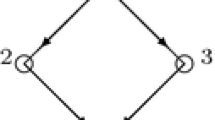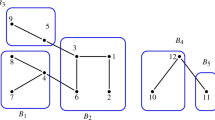Abstract
In this paper, the set of feasible coalitions in a cooperative game is given by a union stable system. Well-known examples of such systems are communication situations and permission structures. Two games associated with a game on a union stable system are the restricted game (on the set of players in the game) and the conference game (on the set of supports of the system). We define two types of superfluous support property through these two games and provide new characterizations for the Myerson value. Finally, we analyze inheritance of properties between the restricted game and the conference game.
Similar content being viewed by others
Notes
Although in the beginning of this section, we mentioned that we always take as player set N={1,…,n}, the definition of the conference game is the only occasion where we deviate from this. Note that the player set in a conference game is still derived from a structure on N.
References
Myerson, R.B.: Graphs and cooperation in games. Math. Oper. Res. 2, 225–229 (1977)
Owen, G.: Values of graph-restricted games. SIAM J. Algebr. Discrete Methods 7, 210–220 (1986)
Borm, P., Owen, G., Tijs, S.H.: On the position value for communication situations. SIAM J. Discrete Math. 5, 305–320 (1992)
van den Nouweland, A., Borm, P., Tijs, S.H.: Allocation rules for hypergraph communication situations. Int. J. Game Theory 20, 255–268 (1992)
Potters, J.A.M., Reijnierse, H.: Γ-Component additive games. Int. J. Game Theory 24, 49–56 (1995)
Myerson, R.B.: Conference structures and fair allocation rules. Int. J. Game Theory 9, 169–182 (1980)
Algaba, E., Bilbao, J.M., Borm, P., López, J.J.: The position value for union stable systems. Math. Methods Oper. Res. 52, 221–236 (2000)
Algaba, E., Bilbao, J.M., Borm, P., López, J.J.: The Myerson value for union stable structures. Math. Methods Oper. Res. 54, 359–371 (2001)
van den Brink, R.: An axiomatization of the disjunctive permission value for games with a permission structure. Int. J. Game Theory 26, 27–43 (1997)
Gilles, R.P., Owen, G., van den Brink, R.: Games with permission structures: the conjunctive approach. Int. J. Game Theory 20, 277–293 (1992)
Algaba, E., Bilbao, J.M., López, J.J.: The position value in communication structures. Math. Methods Oper. Res. 59, 465–477 (2004)
Faigle, U., Grabish, M., Heyne, M.: Monge extensions of cooperation and communication structures. Eur. J. Oper. Res. 206, 104–110 (2010)
van den Nouweland, A.: Games and graphs in economics situations. Ph.D. Thesis, Tilburg University (1993)
van den Brink, R.: On hierarchies and communication. Soc. Choice Welf. (2011). doi:10.1007/s00355-011-0557-y
Shapley, L.S.: A value for n-person games. In: Kuhn, H.W., Tucker, A.W. (eds.) Contributions to the Theory of Games, vol. II, pp. 307–317. Princeton University Press, Princeton (1953)
Meessen, R.: Communication games. M.S. Thesis, Nijmegen University (1988)
van den Brink, R., van der Laan, G., Pruzhansky, V.: Harsanyi power solutions for graph-restricted games. Int. J. Game Theory 40, 87–110 (2011)
Algaba, E., Bilbao, J.M., van den Brink, R.: Harsanyi power solutions for games on union stable systems. Tinbergen Discussion Paper 11/127-1, Tinbergen Institute and VU University, Amsterdam (2011)
van den Nouweland, A., Borm, P.: On the convexity of communication games. Int. J. Game Theory 19, 421–430 (1990)
Bondareva, O.: Some applications of linear programming methods to the theory of cooperative games. Probl. Kibern. 10, 119–139 (1963)
Shapley, L.S.: On balanced sets and cores. Nav. Res. Logist. Q. 14, 453–460 (1967)
Algaba, E., Bilbao, J.M., López, J.J.: A unified approach to restricted games. Theory Decis. 50, 333–345 (2001)
Jackson, M.O., Wolinsky, A.: A strategic model of social and economic networks. J. Econ. Theory 71, 44–74 (1996)
Acknowledgements
This research was finished while the first author was visiting Tinbergen Institute and VU University Amsterdam, under grant Ref. 24022011 of Seville University. Also, this visit was partially supported by Tinbergen Institute. Moreover, this work was presented in some conferences under financial support of the project ECO201017766.
Author information
Authors and Affiliations
Corresponding author
Additional information
Communicated by Irinel Chiril Dragan.
Rights and permissions
About this article
Cite this article
Algaba, E., Bilbao, J.M., van den Brink, R. et al. The Myerson Value and Superfluous Supports in Union Stable Systems. J Optim Theory Appl 155, 650–668 (2012). https://doi.org/10.1007/s10957-012-0077-7
Received:
Accepted:
Published:
Issue Date:
DOI: https://doi.org/10.1007/s10957-012-0077-7




